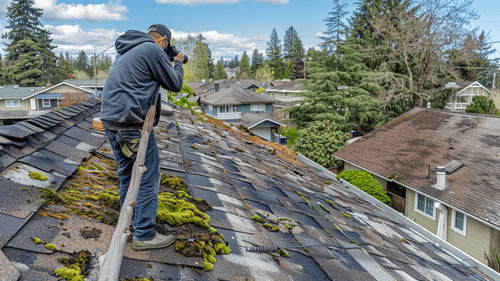Introduction
In Texas, where extreme weather is a fact of life, your roof plays a critical role in safeguarding your home. From intense heatwaves and hailstorms to heavy winds and hurricanes, the Lone Star State's unique climate puts your roof to the ultimate test. Why do some roofs fail under these conditions while others stand strong? Knowing how to build resilience into your roof can make all the difference.
This guide is packed with expert tips tailored to Texas homeowners, from the latest advancements in roofing technology to practical maintenance strategies and upgrades designed to withstand the harshest elements. We’ll explore why certain regions in Texas experience more roof damage, how modern materials are improving durability, and what steps you can take to ensure your roof—and your home—are prepared for anything.
Whether it’s choosing the right materials to combat the Texas heat or scheduling routine inspections before storm season, this article provides the tools and advice you need to protect your roof, your home, and your family from severe weather. Stay Texas-tough and ready for whatever Mother Nature has in store.
Understanding Roof Vulnerability: Insights and Trends
Financial Impact of Tropical Cyclones
Tropical cyclones have historically posed a significant financial burden, with damages surpassing $1.3 trillion and an average cost of $22.8 billion per event. These figures underscore the critical need for robust roofing systems, especially in hurricane-prone areas. A survey of 200 homes revealed that roofs installed before 2015 were significantly more likely to sustain damage during such events, with a staggering 90% showing signs of impairment compared to only 28% of those installed after 2015. This data highlights the importance of modern roofing technologies and materials in mitigating financial losses.
Material Degradation Over Time
Roofing materials, particularly asphalt-shingle roofs, are known to deteriorate over time. After 15 years, more than 90% of these roofs exhibit visible damage, and their susceptibility to damage escalates dramatically under extreme weather conditions, with a 40% likelihood of damage at wind speeds over 130 mph. This degradation not only compromises the roof's structural integrity but also increases the vulnerability of homes to severe weather impacts, emphasizing the need for periodic updates and maintenance.
Regional Susceptibility
In the Gulf Coast region, a concerning 72% of homes have roofs that are susceptible to hurricane damage. This high vulnerability rate can be attributed to both the frequent occurrence of hurricanes and the types of roofing materials commonly used in the area. Understanding these regional specificities is crucial for homeowners when planning roofing installations or upgrades, ensuring that their choices align with the environmental demands.
Modern Roofing Technologies and Materials: Enhancing Resilience
Innovations Post-2015
Since 2015, significant advancements in roofing technology have been made, contributing to a decrease in damage rates during hurricanes. Modern materials and installation techniques have improved roofs' resilience against extreme weather, offering better protection and longer lifespans. These innovations not only enhance safety but also reduce the need for frequent repairs and replacements, ultimately providing cost savings for homeowners.
Material Choices for High Wind Resistance
Choosing the right roofing material is critical for areas frequently hit by high winds. Options such as metal roofing, modified bitumen, and high-grade asphalt shingles are known for their high wind resistance. Each material comes with its pros and cons:
- Metal Roofing: Highly durable and wind-resistant but can be more expensive.
- Modified Bitumen: Offers good wind resistance and is easier to repair but may not suit all aesthetic preferences.
- High-Grade Asphalt Shingles: Less expensive and visually versatile but may require more frequent maintenance.
Roofing Standards and Building Codes
The evolution of building codes has played a pivotal role in enhancing roof resilience. These regulations ensure that roofing installations meet a minimum standard of resistance to extreme weather, guiding both material selection and installation processes. Adhering to these standards is not only a legal requirement but also a critical measure in safeguarding homes against the increasing frequency of severe weather events.
Preventive Measures and Regular Maintenance: Securing Your Investment
Routine Inspections
Regular roof inspections are essential to identify and address potential vulnerabilities before they escalate into significant damages. Homeowners are advised to conduct these inspections at least twice a year and after every major storm. This proactive approach allows for the timely detection of issues such as loose shingles, clogged gutters, and structural weaknesses.
Maintenance Tips
Maintaining a roof in good condition extends its lifespan and enhances its performance against extreme weather. Key maintenance tips include:
- Regularly cleaning gutters to prevent water buildup.
- Removing debris from the roof to avoid additional weight and water trapping.
- Checking for and replacing damaged or missing shingles promptly.
Professional Assessment and Services
After severe weather events, it's advisable to have a professional roof inspection to assess any hidden damage that might not be immediately apparent. These assessments should cover structural integrity, moisture levels, and overall material condition. Professional services can also offer more thorough maintenance checks, ensuring that the roof remains in optimal condition for facing future weather challenges.
Strategic Upgrades and Long-term Investments: Balancing Costs and Benefits
Cost vs. Benefit Analysis
Investing in modern, high-quality roofing may involve significant upfront costs, but the long-term benefits—reduced repair needs, enhanced safety, and potential insurance premium reductions—can outweigh these initial expenses. Homeowners should consider these factors carefully, evaluating how an investment in better roofing materials can lead to substantial savings and increased property value over time.
Enhancements for Existing Roofs
For homes with existing roofs that are not yet due for replacement, several enhancements can improve their weather resistance:
- Adding roof straps can help secure the roof to the building structure, reducing the risk of uplift during high winds.
- Applying sealants and waterproofing treatments can prevent water infiltration, a common issue during heavy rains.
Insurance Considerations
Upgrading a roof can positively impact home insurance premiums. Many insurance companies offer discounts for homes with weather-resistant roofs, recognizing the reduced risk of damage and subsequent claims. Homeowners should consult with their insurance providers to understand how roof upgrades can lead to financial benefits under their specific policy terms.
Wrapping It Up: Securing Your Home Against Nature's Fury
The resilience of your roof is paramount in safeguarding your home from extreme weather events, which are becoming increasingly frequent and intense. Our exploration has shown that modern roofing technologies and materials significantly enhance the durability and longevity of roofs, especially in regions prone to severe weather. By investing in high-quality materials like metal roofing or high-grade asphalt shingles and adhering to updated building codes, homeowners can dramatically reduce the likelihood of damage. Regular maintenance, including routine inspections and timely repairs, plays a crucial role in maintaining the structural integrity of your roof.
Reflecting on the vulnerabilities discussed, it's clear that proactive measures are essential. The financial impact of neglecting these could be devastating, as evidenced by the staggering costs associated with tropical cyclones and other severe weather events. While the initial investment in a robust roofing system may seem substantial, the long-term savings, enhanced safety, and peace of mind it brings, underscore its value. Remember, a well-maintained roof does not merely cover your home; it protects your sanctuary. Let's not wait for the storm to prove its strength.







